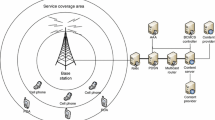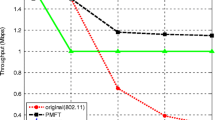Abstract
In this paper we present a novel multicast near-Video on Demand (nVoD) coding schema, which relies on the intrinsic redundancy of the underlying nVoD protocol to provide implicit error correction, by employing content segments as blocks for coding operations. As a result, this implicit error correction has zero overhead, unlike the direct application of error-correcting codes, which increase content bitrate in the same proportion as target error probability. The findings in this paper indicate that our proposal outperforms previous approaches with explicit error correction (error protection within content segments) in terms of transmission bandwidth for the same packet loss probability. We present an analytical approach that can be used to tune implicit error correction (coding matrix selection), which we validate with simulations. We also simulate the impact of the coding schema on two different nVoD protocols, fast broadcasting (FB) and recursive frequency splitting (RFS). Finally, we show the benefits of applying this schema to a real scenario with WiMax transport.






















Similar content being viewed by others
References
Asorey-Cacheda R, González-Castaño FJ (2008) A multicast nVoD schema with zero-overhead implicit error correction. In: Proc. IEEE intl. communications conference 2008, 19–23 May 2008, pp 2017–2020
Azad SA, Murshed M, Dooley LS (2003) A novel batched multicast patching scheme for video broadcasting with low user delay. In: Proc. 3rd IEEE international symposium on signal processing and information technology (ISSPIT), pp 339–342
Eager D, Vernon M, Zahorjan J (1999) Bandwidth skimming: a technique for cost-effective video-on-demand. Tech. Rep. CS-TR-1999-1408, Computer Science Department, Univ. of Wisconsin-Madison
Hua KA, Cai Y, Sheu S (1998) Patching: a multicast technique for true video-on-demand services. In: Proc. 6th ACM international conference on multimedia, pp 191–200
Janakiraman R, Waldvogel M, Xu L (2002) Fuzzycast: efficient video-on-demand over multicast. In: Proc. Infocom 2002, pp 920–929
Juhn L, Tseng L (1997) Harmonic broadcasting for video-on-demand service. IEEE Trans Broadcast 43(3):268–271
Juhn L, Tseng L (1997) Fast broadcasting for hot video access. In: Proc. 4th international workshop on real-time computing systems and applications, 27–29 October 1997, pp 237–243
Ma H, Shin KG (2002) Multicast video-on-demand services. ACM Comput Commun Rev 32(1):31–43
Ma H, Shin KG, Wu W (2005) Best-effort patching for multicast true VoD service. Multimedia Tools and Applications 26(1):101–122
Mahanti A, Eager D, Vernon MK, Sundaram-Stukel DJ (2003) Scalable on-demand media streaming with packet loss recovery. IEEE/ACM Trans Netw 11(2):195–209
Paris JF (1999) A simple low-bandwidth broadcasting protocol for video-on-demand. In: Proc. 8th intl. conf. on computer communications and networks, pp 690–697
Paris JF (2001) A fixed-delay broadcasting protocol for video-on-demand. In: Proc. 10th intl. conf. on computer communications and networks, pp 418–423
Paris JF (2005) A simple but efficient broadcasting protocol for video-on-demand. In: Proc. 24th IEEE intl. performance, computing, and communications conference, 7–9 April 2005, pp 167–174
Peng C, Shen H, Xiong N, Yang LT (2006) Discrete broadcasting protocols for video-on-demand. Lect Notes Comput Sci 4208:642–652
Reisslein M, Saparilla D, Ross KW (2004) Periodic broadcasting with VBR-encoded video. Multimedia Systems 9, pp 503–516
Sujatha DN, Girish K, Venugopal KR, Patnaik LM (2007) An integrated quality-of-service model for video-on-demand application. IAENG Int J Comput Sci 34(1):1–10
Sun Y, Kameda T (2005) Harmonic block windows scheduling through harmonic windows scheduling. Multimed Inf Syst 3665:190–206
Tseng Y-C, Yang M-H, Chang C-H (2002) A recursive frequency-splitting scheme for broadcasting hot videos in VOD service. IEEE Trans Commun 50(8):1348–1355
Xie F, Hua KA, Jiang N (2007) Achieving true video-on-demand service in multi-hop wimax mesh networks. In: Proc. 32nd IEEE conference on local computer networks, 15–18 October 2007, pp 287–294
Yu H-F (2008) Hybrid broadcasting with small buffer demand and waiting time for video-on-demand applications. IEEE Trans Broadcast 54(2):304–311
Yu H-F, Yang H-C, Tseng L-M (2007) Reverse fast broadcasting (RFB) for video-on-demand applications. IEEE Trans Broadcast 53(1):103–111
Yu H-F, Chen Y-N, Yang H-C, Yang Z-Y, Tseng L-M (2008) An efficient scheme for broadcasting popular videos at low buffer demand. Comput Commun 31(10):2270–2279
Yu H-F, Yang H-C, Wang Y-T, Fan P-L, Chien C-Y (2009) Broadcasting scheme with low client buffers and bandwidths for video-on-demand applications. Multimedia Tools and Applications 42(3):295–316
Yu H-F, Ho P-H, Yang H-C (2009) Generalized sequence-based and reverse sequence-based models for broadcasting hot videos. IEEE Trans Multimedia 11(1):152–165
Acknowledgements
The work described in this paper has been supported by grants MIND-GAP-5 PGIDIT 08TIC010CT (Xunta de Galicia, Spain) and CON-PARTE-2 TEC2007-67966-C03-02 (Ministerio de Educación y Ciencia, Spain).
Author information
Authors and Affiliations
Corresponding author
Rights and permissions
About this article
Cite this article
González-Castaño, F.J., Asorey-Cacheda, R., Cerezo-Costas, H. et al. A zero-overhead error-correcting nVoD schema. Multimed Tools Appl 48, 291–312 (2010). https://doi.org/10.1007/s11042-009-0331-7
Published:
Issue Date:
DOI: https://doi.org/10.1007/s11042-009-0331-7




